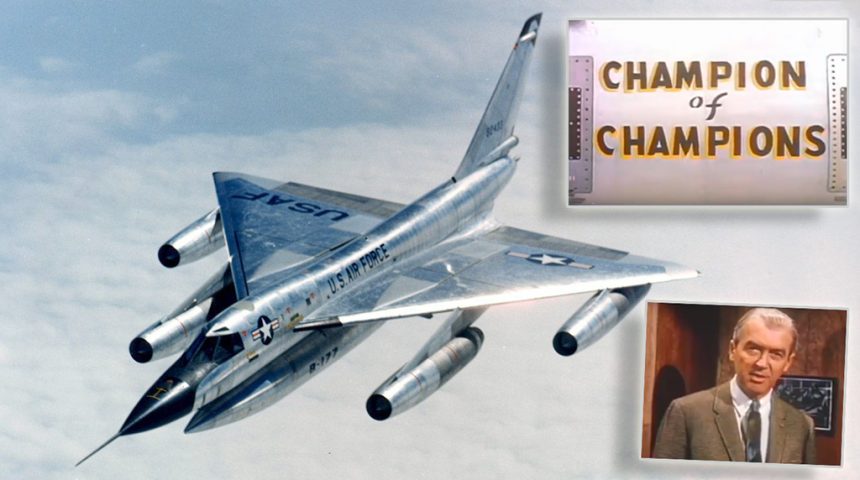Narrated by (Brigadier General and) actor James Stewart, this 1960s film documents the many records of the Mach 2+ supersonic bomber.
Powered by four General Electric J79 engines in underwing pods and designed around a large delta wing, the Convair B-58 Hustler was the first operational bomber capable of flying at Mach 2. The aircraft was developed in the 1950s for the Strategic Air Command (SAC) of the U.S. Air Force, made its first flight on Nov. 11, 1956, and entered the active service in March 1960. It operated throughout the 1960s flying with the 43rd Bombardment Wing, at Carswell Air Force Base, Texas; and the 305th Bombardment Wing at Bunker Hill AFB, Indiana (later renamed Grissom AFB, after after Lt. Col. Virgil I. “Gus” Grissom, USAF, a native of Mitchell, Indiana, one of the original seven Mercury astronauts who lost his life in the fire of his Apollo 1 capsule during a pre-launch rehearsal at Cape Kennedy, Florida, in January 1967).
Convair built 116 B-58s: 30 test and pre-production aircraft and 86 for operational service.
The first supersonic bomber had a thin fuselage that prevedented the carrying of bombs internally. For this reason the aircraft, whose crew consisted of a pilot, navigator/bombardier and a DSO (defense systems operator), carried a droppable, two-component pod beneath the fuselage, that contained a nuclear weapon, along with extra fuel, reconnaissance equipment or other specialized gear. According to the U.S. Air Force, other distinctive features included a sophisticated inertial guidance navigation and bombing system, a slender “wasp-waist” fuselage and an extensive use of heat-resistant honeycomb sandwich skin panels in the wings and fuselage. The aircraft was also equipped with an escape module: on Mar. 21, 1962, a 2-year old black bear named “Yogi” was ejected from a U.S. Air Force B-58 during tests of the Hustler’s escape capsule.
Originally, the B-58’s mission was to fly high and fast to avoid the Soviet interceptors. However, along with a strategic relevance, the top speed of the aircraft allowed the Hustler to achieve 19 world speed and altitude records and win five different aviation trophies.
The video below, dating back to the early 1960s, features Brig. Gen. ret. James Stewart (a vet. WWII pilot) walking the audience through the virtues of the bomber and the review of some of the B-58’s records and trophies. A real gem coming from the Cold War era.
The B-58 set 19 world speed records by 1963. On Oct. 16, 1962, B-58 61-2059 crewed by Major Sidney Kubesch, Major John Barrett and Captain Gerard Williamson, flew supersonically from Tokyo to London, spending five hours at supersonic speed. The flight set five world absolute records.
Previously, on Jan. 14, 1961 it gained three international speed and payload records by flying a 1,000 kilometer (621.5 mile) course at 1,284 MPH. The crew on this flight received the Thompson Trophy. On Mar. 5, 1962 it won the Bendix and Mackay trophies by flying from Los Angeles to New York at an average speed of 1,214.71 MPH and then returning at an average speed of 1,081.77 MPH. Eventually, the B-58 won several trophies, including the Bleriot trophy, the Thompson trophy, the Mackay trophy, the Bendix trophy and the Harmon trophy.
Although the B-58 is still cosidered one of the most interesting and handsome bombers ever, its operational career was pretty short.
The phaseout of the fleet was ordered at the end of 1965, when the Soviets introduced highly accurate surface-to-air missiles and it was felt that the Hustler’s high-altitude attack profile could no longer guarantee success against increasingly sophisticated Soviet air defenses. Moreover, the aircraft was substantially more expensive to operate than other bombers, such as the (almost immortal) Boeing B-52 Stratofortress, and also suffered from a high rate of accidental losses. All of this led to a relatively brief career of ten years: the B-58 was retired on Jan. 31, 1970, and replaced by the FB-111.
A big thank you to our follower Filippo Demartini for pointing us to this cool video!









